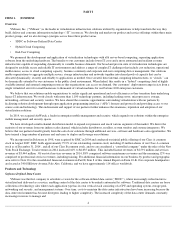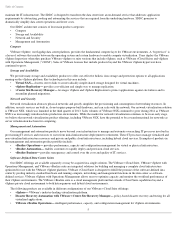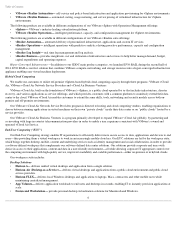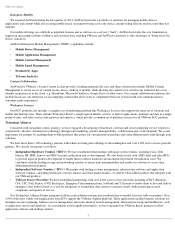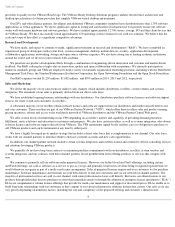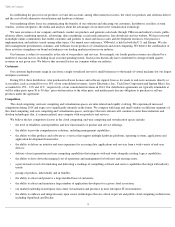VMware 2014 Annual Report Download - page 16
Download and view the complete annual report
Please find page 16 of the 2014 VMware annual report below. You can navigate through the pages in the report by either clicking on the pages listed below, or by using the keyword search tool below to find specific information within the annual report.
Table of Contents
of their existing relationships to engage in business practices that make our products and services less attractive to our end users. Other
competitors have limited or denied support for their applications running in VMware virtualization environments. These distribution, licensing
and support restrictions, as well as other business practices that may be adopted in the future by our competitors, could materially impact our
prospects regardless of the merits of our products and services.
In addition, competitors with existing relationships with our current or prospective end users could in the future integrate competitive
capabilities into their existing products and services and make them available without additional charge. For example, Oracle provides free
server virtualization software intended to support Oracle and non-
Oracle applications, and Microsoft offers its own server virtualization software
packaged with its Windows Server product and offers built-in virtualization in the client version of Windows. As a result, existing and
prospective VMware customers may elect to use products that are perceived to be “free” or “very low cost” instead of purchasing VMware
products and services for certain applications where they do not believe that more advanced and robust capabilities are required. Competitors
may also leverage open source technologies to offer zero or low cost products and services capable of putting pricing pressure on our own
product offerings. By engaging in such business practices, our competitors can diminish competitive advantages we may possess by
incentivizing end users to choose products that lack some of the technical advantages of our own offerings. In addition, even if customers find
our products and services to be technically superior, they may choose to employ a “ multiple-vendor ” strategy, where they purposely deploy
multiple vendors in their environment in order to prevent any one vendor from gaining too much control over their IT operations.
We also face potential competition from our partners. For example, third parties currently selling our products and services could build and
market their own competing products and services or market competing products and services of other vendors. If we are unable to compete
effectively, our growth and our ability to sell products and services at profitable margins could be materially and adversely affected, which could
materially and adversely impact our financial condition and results of operations.
Industry alliances or consolidation may result in increased competition.
Some of our competitors have made acquisitions and entered into or extended partnerships or other strategic relationships to offer more
comprehensive virtualization and cloud computing solutions than they individually had offered. Citrix Systems continues to invest in desktop
virtualization marketing by continuing its collaboration with Microsoft and has acquired smaller players like Zenprise, Virtual Computer and
Framehawk. IBM acquired SoftLayer to increase their data center footprint and grow their cloud business. Moreover, information technology
companies are increasingly seeking to deliver top-to-bottom IT solutions to end users that combine enterprise-level hardware and software
solutions to provide an alternative to our virtualization platform. For example, Oracle offers integrated hardware and software virtualization
solutions, and Microsoft and Hewlett-Packard continue their collaboration based on Microsoft’
s cloud computing and virtualization platforms. In
addition, Citrix offers an IaaS cloud services solution, and Red Hat continues to invest in the Open Virtualization Alliance (“OVA”) to bolster
KVM as a direct competitor to VMware vSphere.
A number of competitors are active in the emerging software-defined networking space. For example, in 2013, Cisco acquired Insieme. In
June 2013, Oracle and Microsoft entered into a partnership pursuant to which Oracle now supports the use of Oracle products in Microsoft
Hyper-V deployments as well as Windows Azure. In July 2014, Cisco and Microsoft announced an initiative to integrate Cisco data center
solutions and networking switches with Microsoft cloud offerings and to jointly market and sell their data center and hybrid cloud solutions. In
September 2014, Cisco and RedHat announced a new integrated infrastructure solution for OpenStack-based cloud deployments. In addition, the
companies announced an expansion of their relationship, accelerating collaboration around OpenStack, Application Centric Infrastructure and
Intercloud. We expect these trends to continue as companies attempt to strengthen or maintain their positions in the evolving virtualization
infrastructure and enterprise IT solutions industry. Many of the companies driving this trend have significantly greater financial, technical and
other resources than we do and may be better positioned to acquire and offer complementary products and technologies. The companies and
alliances resulting from these possible combinations may create more compelling product and service offerings and be able to offer greater
pricing flexibility than we can or may engage in business practices that make it more difficult for us to compete effectively, including on the
basis of price, sales and marketing programs (such as providing greater incentives to our channel partners to sell a competitor’s product),
technology or product functionality. This competition could result in a substantial loss of customers or a reduction in our revenues, which could
materially and adversely impact our financial condition and results of operations.
Our new product and technology initiatives subject us to additional business, legal and competitive risks.
Over the last several years, we have introduced new product and technology initiatives that aim to leverage our virtualization infrastructure
software products into the emerging areas of cloud computing and end-user computing as alternatives to the provisioning of physical computing
resources.
One of our core strategies is to deliver the software-defined data center. In 2012, we acquired two companies that furthered our software
defined data center ( “ SDDC”) strategy—Dynamic Ops, a provider of cloud automation solutions that enable
14


